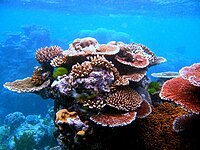
Coral-associated bacteria demonstrate phylosymbiosis and cophylogeny
Sign Up to like & getrecommendations! Published in 2018 at "Nature Communications"
DOI: 10.1038/s41467-018-07275-x
Abstract: Scleractinian corals’ microbial symbionts influence host health, yet how coral microbiomes assembled over evolution is not well understood. We survey bacterial and archaeal communities in phylogenetically diverse Australian corals representing more than 425 million years… read more here.
Keywords: associated bacteria; coral associated; demonstrate phylosymbiosis; bacteria demonstrate ... See more keywords

Host phylogeny and functional traits differentiate gut microbiomes in a diverse natural community of small mammals
Sign Up to like & getrecommendations! Published in 2023 at "Molecular Ecology"
DOI: 10.1111/mec.16874
Abstract: Differences in the bacterial communities inhabiting mammalian gut microbiomes tend to reflect the phylogenetic relatedness of their hosts, a pattern dubbed phylosymbiosis. Although most research on this pattern has compared the gut microbiomes of host… read more here.
Keywords: phylosymbiosis; functional traits; traits differentiate; host phylogeny ... See more keywords
Phylosymbiosis Impacts Adaptive Traits in Nasonia Wasps
Sign Up to like & getrecommendations! Published in 2019 at "mBio"
DOI: 10.1128/mbio.00887-19
Abstract: Phylosymbiosis is an ecoevolutionary hypothesis and emerging pattern in animal-microbiota studies whereby the host phylogenetic relationships parallel the community relationships of the host-associated microbiota. A central prediction of phylosymbiosis is that closely related hosts exhibit… read more here.
Keywords: biology; closely related; related species; microbiota ... See more keywords

Limited Evidence for Microbial Transmission in the Phylosymbiosis between Hawaiian Spiders and Their Microbiota
Sign Up to like & getrecommendations! Published in 2022 at "mSystems"
DOI: 10.1128/msystems.01104-21
Abstract: How host-associated microbiotas assemble and evolve is one of the outstanding questions of microbial ecology. Studies aiming at answering this question have repeatedly found a pattern of “phylosymbiosis,” that is, a phylogenetic signal in the… read more here.
Keywords: phylosymbiosis; ecology; vertical transmission; evidence ... See more keywords

Insights Into the Species-Specific Microbiota of Greenideinae (Hemiptera: Aphididae) With Evidence of Phylosymbiosis
Sign Up to like & getrecommendations! Published in 2022 at "Frontiers in Microbiology"
DOI: 10.3389/fmicb.2022.828170
Abstract: Aphids and their symbionts represent an outstanding model for studies of insect–symbiont interactions. The aphid microbiota can be shaped by aphid species, geography and host plants. However, the relative importance of phylogenetic and ecological factors… read more here.
Keywords: phylosymbiosis; greenideinae; geography; aphid species ... See more keywords